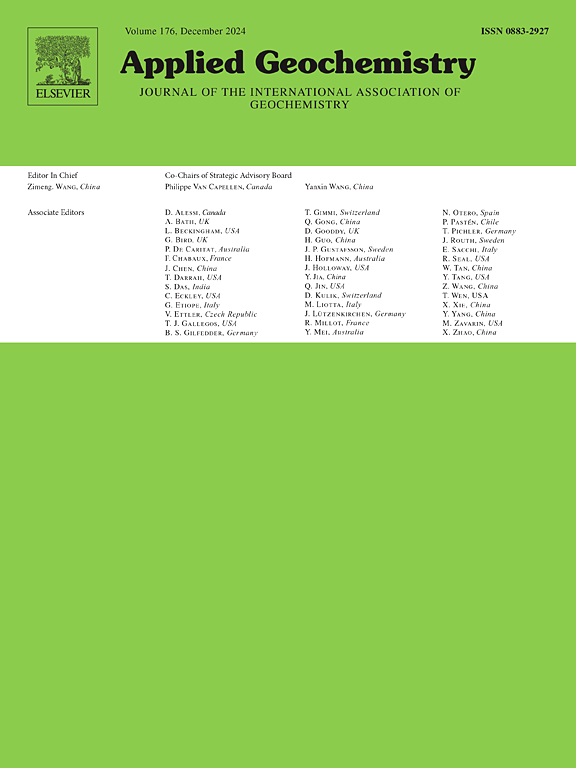Contrasting effects of ecological restoration and sewage input on the carbonate system variability in an urban river on the Loess Plateau
IF 3.4
3区 地球科学
Q1 GEOCHEMISTRY & GEOPHYSICS
引用次数: 0
Abstract
Intensive human disturbances have led to complex internal variations in the riverine CO2 system, especially in the urbanized rivers in semi-arid areas. This study examines the factors controlling carbonate system in a river draining an urban ecological restoration area on the Loess Plateau, North China, where riverine dissolved inorganic carbon (DIC) and CO2 partial pressure (pCO2) exhibited pronounced variations influenced by land use changes. The most notable changes included a decrease in DIC (24.0 mg L−1) and pCO2 (280 μatm) in the urban restored area with damming, driven by strong aquatic photosynthesis, and a sharp increase in DIC (55.7 mg L−1) and pCO2 (6,222 μatm) in the urban downstream, attributed to sewage input. In contrast, in the upstream of the urban restored area, DIC (33.8 mg L−1) and pCO2 (723 μatm) were mainly controlled by carbonate weathering. Overall, this river acted as a strong atmospheric CO2 source, with an average CO2 emission of 450.1 mmol m−2 d−1, slightly higher than the global riverine average (359.4 mmol m−2 d−1), and exhibited pronounced spatial variability. A CO2 sink (−11.2 mmol m−2 d−1) developed in the urban restoration area, whereas sewage input at urban downstream transformed the river into a strong CO2 source (1,668.5 mmol m−2 d−1), highlighting the impact of anthropogenic perturbations on riverine CO2 source - sink dynamics. Therefore, enhancing urban ecological restoration while effectively reducing CO2 emission from sewage is crucial for achieving CO2 neutrality in urban rivers, particularly in arid and semi-arid climates.
生态恢复与污水输入对黄土高原某城市河流碳酸盐系统变异的对比影响
强烈的人为干扰导致了河流CO2系统复杂的内部变化,特别是在半干旱地区的城市化河流中。研究了黄土高原某城市生态恢复区河道溶解度无机碳(DIC)和CO2分压(pCO2)受土地利用变化的影响而显著变化的影响因素。其中最显著的变化是由于水体光合作用的作用,城市筑坝恢复区DIC (24.0 mg L−1)和pCO2 (280 μatm)的降低,而城市下游地区DIC (55.7 mg L−1)和pCO2 (6222 μatm)的急剧增加,主要原因是污水的输入。而在城市恢复区上游,DIC (33.8 mg L−1)和pCO2 (723 μatm)主要受碳酸盐风化作用控制。总体而言,该河流是一个较强的大气CO2源,平均CO2排放量为450.1 mmol m−2 d−1,略高于全球河流平均值(359.4 mmol m−2 d−1),并表现出明显的空间变异性。城市恢复区形成了一个CO2汇(- 11.2 mmol m−2 d−1),而城市下游的污水输入将河流转变为一个强CO2源(1,668.5 mmol m−2 d−1),突出了人为扰动对河流CO2源-汇动态的影响。因此,在加强城市生态恢复的同时,有效减少污水中二氧化碳的排放,对于实现城市河流中二氧化碳的中和至关重要,尤其是在干旱和半干旱气候条件下。
本文章由计算机程序翻译,如有差异,请以英文原文为准。
求助全文
约1分钟内获得全文
求助全文
来源期刊

Applied Geochemistry
地学-地球化学与地球物理
CiteScore
6.10
自引率
8.80%
发文量
272
审稿时长
65 days
期刊介绍:
Applied Geochemistry is an international journal devoted to publication of original research papers, rapid research communications and selected review papers in geochemistry and urban geochemistry which have some practical application to an aspect of human endeavour, such as the preservation of the environment, health, waste disposal and the search for resources. Papers on applications of inorganic, organic and isotope geochemistry and geochemical processes are therefore welcome provided they meet the main criterion. Spatial and temporal monitoring case studies are only of interest to our international readership if they present new ideas of broad application.
Topics covered include: (1) Environmental geochemistry (including natural and anthropogenic aspects, and protection and remediation strategies); (2) Hydrogeochemistry (surface and groundwater); (3) Medical (urban) geochemistry; (4) The search for energy resources (in particular unconventional oil and gas or emerging metal resources); (5) Energy exploitation (in particular geothermal energy and CCS); (6) Upgrading of energy and mineral resources where there is a direct geochemical application; and (7) Waste disposal, including nuclear waste disposal.
 求助内容:
求助内容: 应助结果提醒方式:
应助结果提醒方式:


